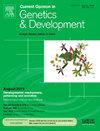小鼠未分化精原细胞发育的动态三维表观基因组重组
IF 3.6
2区 生物学
Q2 CELL BIOLOGY
引用次数: 0
摘要
生殖细胞获得全能性的能力是独一无二的。为此,它们在发育过程中重组其三维(3D)表观基因组,包括分化有丝分裂前原细胞的原始生殖细胞的表观遗传重编程,以及随后产生未分化精原细胞/精原干细胞(SSCs)的独特表观遗传编程。低投入表观基因组学和3D基因组学技术的进步,以及对生殖细胞发育(即体外配子体发生)的可扩展体外重构系统的互补深入表征,已经阐明了这些过程中的一些基本事件。包括有丝分裂前原细胞表观遗传重编程后高度开放染色质的绝缘增强,以及未分化精原细胞/ ssc中伴随染色体径向重新定位的绝缘消除和进一步的去色化。这些三维表观基因组组织可能是产生功能齐全的配子的基础。阐明生殖细胞发育过程中三维表观基因组重组的机制不仅有助于理解全能性的基础,而且有助于进一步推进体外配子体发生。本文章由计算机程序翻译,如有差异,请以英文原文为准。
Dynamic three-dimensional epigenomic reorganization for the development of undifferentiated spermatogonia in mice
Germ cells are unique in their ability to acquire totipotency. Toward this end, they reorganize their three-dimensional (3D) epigenome during their development, including epigenetic reprogramming in primordial germ cells that differentiate mitotic prospermatogonia and ensuing unique epigenetic programming for generating undifferentiated spermatogonia/spermatogonial stem cells (SSCs). Advances in low-input epigenomic and 3D genomic techniques, along with complementary in-depth characterization of scalable in vitro reconstitution systems for germ cell development, that is, in vitro gametogenesis, have elucidated a number of fundamental events during these processes, including insulation augmentation in highly open chromatin following epigenetic reprogramming in mitotic prospermatogonia and insulation erasure and further euchromatization accompanied by chromosomal radial repositioning in undifferentiated spermatogonia/SSCs. These 3D epigenomic organizations likely serve as a foundation for generating fully functional gametes. Elucidating the mechanisms underlying 3D epigenomic reorganization during germ cell development will be instrumental not only for understanding the basis for totipotency but also for further advancing in vitro gametogenesis.
求助全文
通过发布文献求助,成功后即可免费获取论文全文。
去求助
来源期刊
CiteScore
7.90
自引率
0.00%
发文量
102
审稿时长
1 months
期刊介绍:
Current Opinion in Genetics and Development aims to stimulate scientifically grounded, interdisciplinary, multi-scale debate and exchange of ideas. It contains polished, concise and timely reviews and opinions, with particular emphasis on those articles published in the past two years. In addition to describing recent trends, the authors are encouraged to give their subjective opinion of the topics discussed.
In Current Opinion in Genetics and Development we help the reader by providing in a systematic manner:
1. The views of experts on current advances in their field in a clear and readable form.
2. Evaluations of the most interesting papers, annotated by experts, from the great wealth of original publications.[...]
The subject of Genetics and Development is divided into six themed sections, each of which is reviewed once a year:
• Cancer Genomics
• Genome Architecture and Expression
• Molecular and genetic basis of disease
• Developmental mechanisms, patterning and evolution
• Cell reprogramming, regeneration and repair
• Genetics of Human Origin / Evolutionary genetics (alternate years)

 求助内容:
求助内容: 应助结果提醒方式:
应助结果提醒方式:


